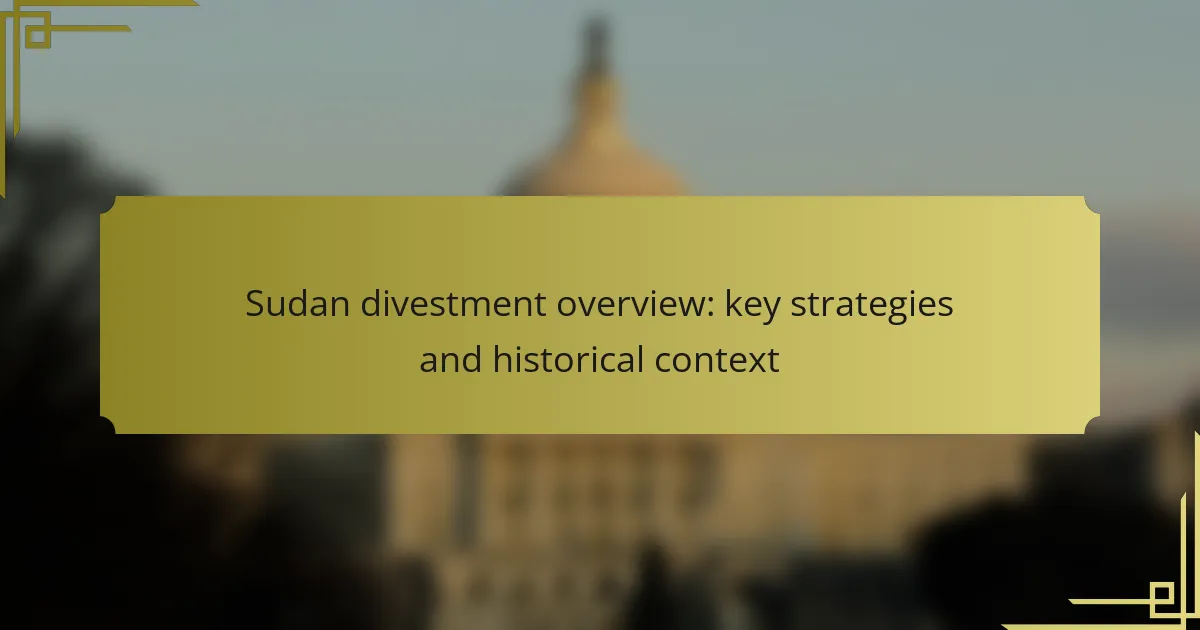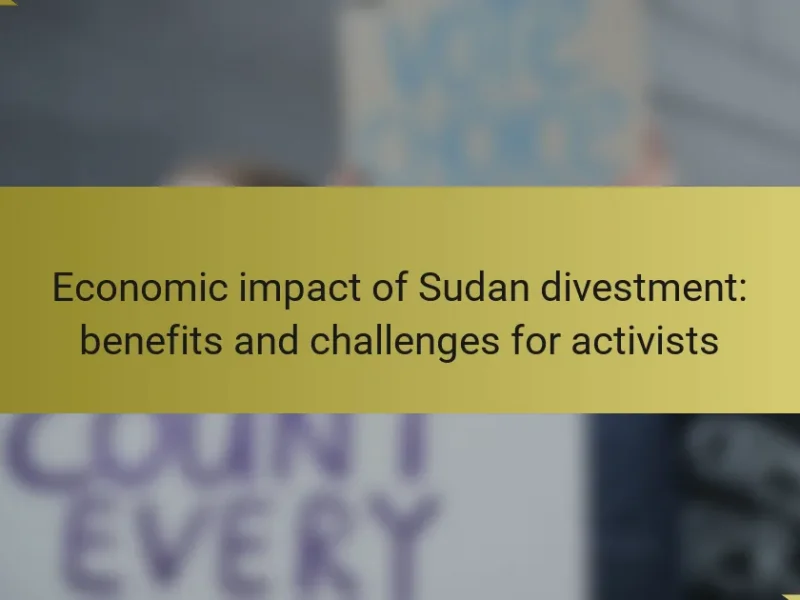Sudan divestment involves the strategic withdrawal of investments from companies operating in Sudan, primarily in response to human rights violations and ongoing conflicts. This movement gained momentum in the 1990s, particularly due to the civil conflict and genocide reports in Darfur, prompting various organizations, states, and universities to adopt divestment policies aimed at pressuring the Sudanese government. Key strategies for stakeholders include assessing current investments, collaborating with advocacy groups, creating structured divestment plans, and engaging with policymakers to foster legislative change. Historical evidence demonstrates that coordinated divestment efforts can effectively influence governmental and corporate practices, as seen in past movements like the divestment against apartheid in South Africa.
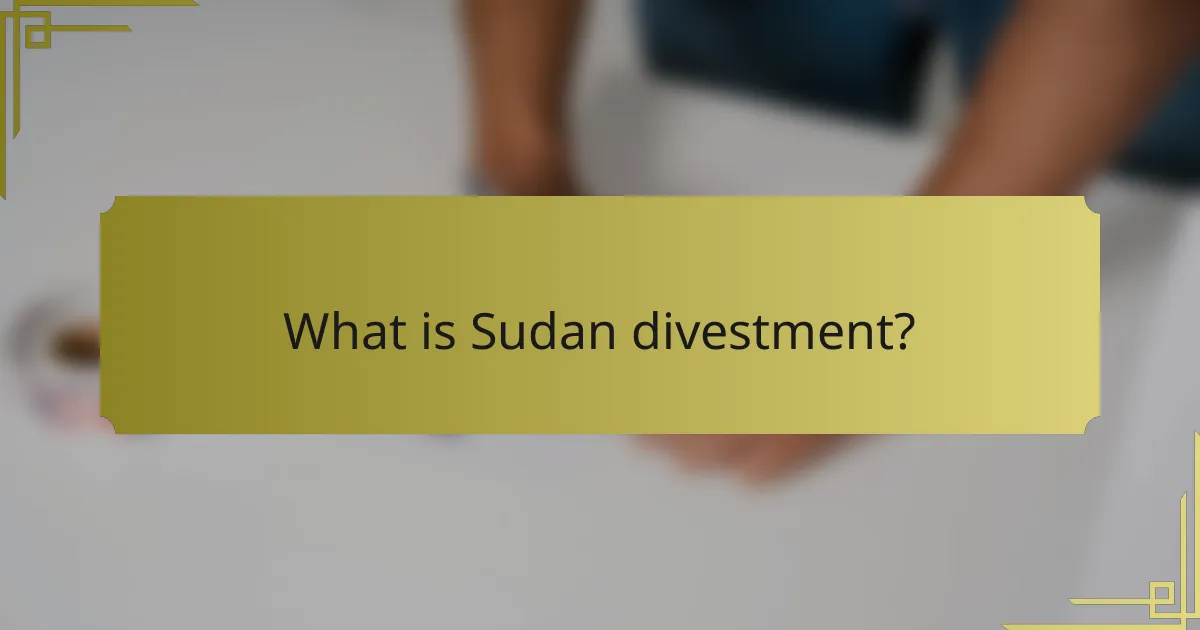
What is Sudan divestment?
Sudan divestment refers to the withdrawal of investments from companies operating in Sudan. This action is often taken in response to human rights violations or conflicts within the country. Many organizations and states have enacted divestment policies to pressure the Sudanese government. For example, the Sudan Divestment Task Force was established to promote this movement. The goal is to encourage positive change through economic pressure. Various universities and pension funds have also adopted similar measures. These initiatives aim to highlight ethical investment practices. Overall, Sudan divestment serves as a tool for advocating for human rights and social justice.
Why is divestment important in the context of Sudan?
Divestment is important in the context of Sudan because it serves as a tool for promoting social and political change. It aims to pressure the Sudanese government to alter its policies, especially regarding human rights abuses. Historical evidence shows that divestment campaigns have successfully influenced governments to adopt more favorable policies. For instance, the divestment movement against South African apartheid played a significant role in its eventual dismantling. In Sudan, international investors pulling out can signal disapproval of the government’s actions. This financial pressure can lead to increased accountability and reform. Thus, divestment acts as a strategic lever in advocating for justice and peace in Sudan.
What are the historical events that led to the need for divestment in Sudan?
The historical events that led to the need for divestment in Sudan include prolonged civil wars and human rights abuses. The First Sudanese Civil War lasted from 1955 to 1972, causing significant displacement and suffering. The Second Sudanese Civil War began in 1983 and continued until 2005. This conflict involved the Sudanese government and various rebel groups, leading to atrocities such as genocide in Darfur. The Darfur conflict, which escalated in 2003, drew international condemnation for widespread violence against civilians. In response, various governments and organizations called for divestment from Sudan to pressure the regime to end human rights violations. These events highlighted the urgent need for action against the Sudanese government’s oppressive policies.
How does divestment impact Sudan’s economy and political landscape?
Divestment negatively impacts Sudan’s economy and political landscape. It leads to reduced foreign investment, limiting economic growth. As companies withdraw, job opportunities decrease, increasing unemployment rates. This economic decline can exacerbate social unrest and instability. Politically, divestment pressures the government to change policies. It often highlights human rights abuses, attracting international scrutiny. The loss of international partnerships can weaken Sudan’s global standing. Overall, divestment creates a cycle of economic hardship and political challenges.
What are the key strategies employed in Sudan divestment?
Key strategies employed in Sudan divestment include economic pressure, ethical investment policies, and targeted sanctions. Economic pressure aims to reduce funding for the Sudanese government. This is often achieved through the withdrawal of investments from companies operating in Sudan. Ethical investment policies encourage institutions to avoid investing in entities that contribute to human rights abuses. Targeted sanctions focus on specific individuals and entities linked to the Sudanese government. These strategies collectively aim to promote change in Sudan’s political landscape and improve human rights conditions.
Which sectors are primarily targeted for divestment in Sudan?
The sectors primarily targeted for divestment in Sudan include oil, mining, and telecommunications. These sectors have been identified due to their association with human rights violations and conflict financing. The oil sector is significant as it generates substantial revenue for the Sudanese government. Mining operations often lead to environmental degradation and displacement of communities. Telecommunications are scrutinized for their role in surveillance and repression. International pressure has intensified to withdraw investments from these sectors. This divestment aims to promote ethical investment practices and support peace initiatives in Sudan.
How do international organizations influence divestment strategies in Sudan?
International organizations influence divestment strategies in Sudan primarily through advocacy and policy recommendations. They often highlight human rights violations and promote economic sanctions. By raising awareness, these organizations can mobilize public opinion against investments in Sudan. This pressure can lead companies to reconsider their operations in the country. For instance, the United Nations and the African Union have both condemned actions in Sudan, urging divestment. Reports from these organizations provide data on the impacts of investments on local communities. Such reports serve as crucial evidence for stakeholders considering divestment. Ultimately, the influence of international organizations shapes the financial landscape in Sudan, guiding ethical investment practices.
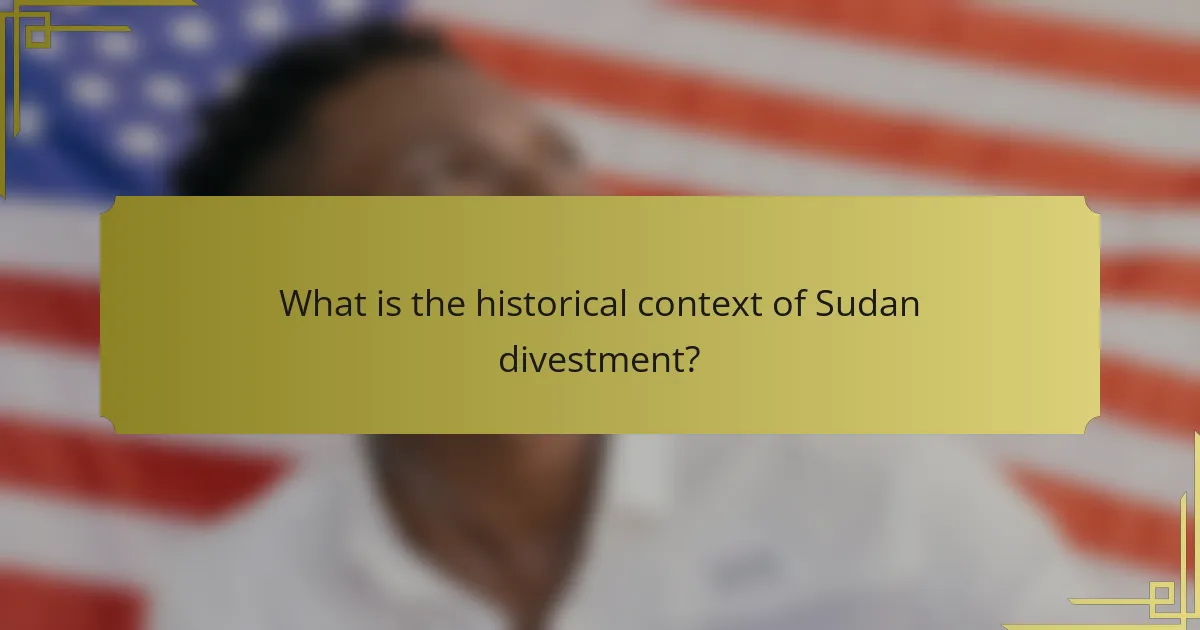
What is the historical context of Sudan divestment?
Sudan divestment refers to the withdrawal of investments from companies operating in Sudan due to human rights violations. The historical context began in the 1990s, amid escalating civil conflict and reports of genocide in Darfur. In response, activists and organizations called for divestment as a means to pressure the Sudanese government. By the early 2000s, numerous states and universities began implementing divestment policies. The U.S. government also imposed economic sanctions against Sudan, further encouraging divestment efforts. These actions aimed to hold the Sudanese regime accountable for its actions and promote peace in the region.
What major events have shaped Sudan’s political and economic environment?
Sudan’s political and economic environment has been shaped by several major events. The First Sudanese Civil War lasted from 1955 to 1972. This conflict significantly affected governance and economic stability. The Second Sudanese Civil War began in 1983 and continued until 2005. It resulted in extensive loss of life and infrastructure. The signing of the Comprehensive Peace Agreement in 2005 aimed to resolve these conflicts. However, it led to South Sudan’s independence in 2011, impacting Sudan’s economy. The Darfur conflict, which started in 2003, further destabilized the region. International sanctions imposed due to human rights violations also affected economic growth. The 2019 ousting of President Omar al-Bashir marked a pivotal shift in Sudan’s political landscape. These events collectively influenced Sudan’s governance, social structures, and economic conditions.
How did the Darfur conflict influence global divestment movements?
The Darfur conflict significantly influenced global divestment movements by raising awareness about human rights abuses. Activists and organizations mobilized to pressure companies linked to the Sudanese government. This pressure led to a widespread divestment campaign targeting firms involved in oil, telecommunications, and other sectors. Notably, the divestment movement gained momentum after the U.S. Congress passed the Darfur Peace and Accountability Act in 2006. This legislation encouraged states and institutions to divest from companies supporting the Sudanese regime. By 2010, numerous universities and pension funds had committed to divesting. The movement illustrated how grassroots activism could impact corporate behavior and policy. Overall, the Darfur conflict served as a catalyst for a broader global divestment strategy focused on social justice.
What role did international sanctions play in shaping divestment actions?
International sanctions significantly influenced divestment actions related to Sudan. These sanctions were implemented to pressure the Sudanese government over human rights abuses and conflicts. As a result, many investors and companies chose to divest from Sudan to avoid reputational damage and legal repercussions. For example, the U.S. imposed comprehensive economic sanctions in 1997, which led to a decline in foreign investment. This created a ripple effect, prompting other nations and organizations to follow suit in their divestment efforts. The sanctions served as a catalyst for divestment by making continued investment in Sudan financially and ethically untenable.
What lessons can be learned from past divestment efforts in Sudan?
Past divestment efforts in Sudan highlight the importance of strategic engagement and targeted pressure. These efforts demonstrate that divestment can raise awareness about human rights abuses. However, they also show that divestment alone may not lead to significant policy changes. The Sudanese government often found ways to circumvent financial pressures. Additionally, successful divestment requires collaboration among international stakeholders. Effective communication of goals and impacts is crucial for mobilizing support. Historical examples indicate that sustained advocacy is necessary to complement divestment efforts. Overall, lessons include the need for a multifaceted approach and the importance of persistent activism.
What were the successes and failures of previous divestment campaigns?
Previous divestment campaigns have seen both successes and failures. Successful campaigns often led to significant financial pressure on targeted entities. For example, the divestment from South Africa during apartheid contributed to the eventual end of that regime. Additionally, some universities and institutions adopted divestment policies in response to social movements.
However, failures also occurred. Many campaigns struggled to achieve substantial economic impact. For instance, divestment efforts related to Sudan did not significantly alter the government’s behavior regarding human rights. Furthermore, some divestment initiatives faced pushback from stakeholders who prioritized financial returns over ethical considerations.
In summary, while divestment campaigns can drive change, their effectiveness varies significantly based on context and stakeholder engagement.
How can these lessons inform future divestment strategies?
Lessons from past divestment strategies can guide future actions effectively. Analyzing historical successes and failures reveals critical factors for success. For instance, targeted divestment from entities linked to human rights abuses proved impactful. In Sudan, divestment led to increased pressure on the government to change policies. Future strategies should prioritize transparency and stakeholder engagement. Additionally, leveraging coalition-building among investors enhances leverage against targeted entities. Historical data shows that coordinated efforts yield stronger outcomes than isolated actions. By focusing on these lessons, future divestment strategies can be more strategic and effective.
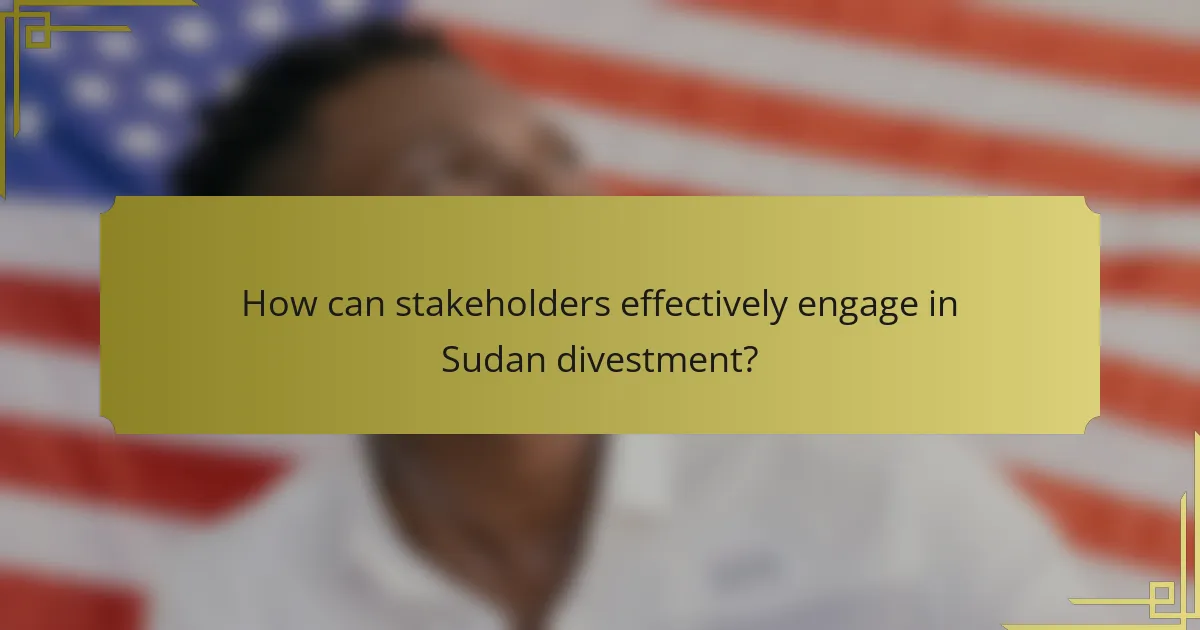
How can stakeholders effectively engage in Sudan divestment?
Stakeholders can effectively engage in Sudan divestment by adopting a strategic approach. This includes assessing their current investments in Sudan and identifying companies that contribute to human rights violations. Stakeholders should also collaborate with advocacy groups to raise awareness about the impact of their investments. Creating a divestment plan is crucial, outlining specific timelines and targets for withdrawing funds. Engaging in dialogue with policymakers can amplify their efforts and influence legislative changes. Monitoring progress and sharing results with the public enhances accountability. Historical evidence shows that coordinated divestment campaigns can pressure governments and corporations to change their practices. For example, the divestment movement against South Africa in the 1980s successfully contributed to the end of apartheid.
What best practices should organizations follow when considering divestment?
Organizations should conduct thorough due diligence before considering divestment. This involves assessing the financial, social, and ethical implications of divesting from specific assets. Engaging stakeholders is crucial for understanding diverse perspectives. Organizations should also develop a clear divestment strategy that outlines objectives and timelines. Transparency in communication is vital to maintain trust with stakeholders. Monitoring the impact of divestment on both the organization and the affected communities is essential. Lastly, organizations should be prepared to adapt their strategies based on evolving circumstances and feedback. These practices help ensure informed and responsible divestment decisions.
How can stakeholders assess the impact of their divestment decisions?
Stakeholders can assess the impact of their divestment decisions by analyzing financial performance metrics. They should evaluate changes in stock prices and market capitalization post-divestment. Assessing reputational impacts through stakeholder surveys can provide insights into public perception. Additionally, stakeholders can review changes in investment flows and capital allocation patterns in affected sectors. Monitoring legislative and regulatory responses related to divestment can also offer valuable data. Engaging with local communities can help gauge social and economic effects. Historical case studies of similar divestments can serve as benchmarks for expected outcomes. Ultimately, a comprehensive assessment combines quantitative and qualitative analyses to understand the broader implications of divestment decisions.
What resources are available for understanding Sudan divestment?
Resources for understanding Sudan divestment include academic articles, policy papers, and reports from non-governmental organizations. The “Sudan Divestment Task Force” provides comprehensive information on divestment strategies. The “United Nations” offers insights into the humanitarian impact of divestment. Research from institutions like “Harvard University” discusses the economic implications of divestment. Additionally, the “Global Witness” organization publishes reports on corporate accountability related to Sudan. These resources collectively enhance the understanding of the complexities surrounding Sudan divestment.
Where can one find comprehensive reports and analyses on Sudan divestment?
Comprehensive reports and analyses on Sudan divestment can be found through several reputable sources. Organizations like the Sudan Divestment Task Force provide detailed reports on divestment efforts. Academic institutions often publish research papers on the topic, available through databases like JSTOR or Google Scholar. Additionally, government agencies and international bodies like the United Nations may release relevant analyses. Nonprofit organizations focused on human rights and economic policies also produce valuable insights. These sources ensure access to credible and thorough information regarding Sudan divestment.
What role do advocacy groups play in promoting awareness of Sudan divestment?
Advocacy groups play a crucial role in promoting awareness of Sudan divestment. They mobilize public opinion against investments in Sudan due to its human rights violations. These organizations conduct research and disseminate information to inform stakeholders. They engage in campaigns to educate the public and policymakers about the consequences of investment in Sudan. Advocacy groups also collaborate with universities and businesses to encourage divestment. They provide resources and toolkits to assist institutions in making informed decisions. Their efforts have led to significant divestment actions from various entities. For example, in 2006, the Sudan Divestment Task Force reported over $3 billion in divestments from companies operating in Sudan.
Sudan divestment refers to the withdrawal of investments from companies operating in Sudan due to human rights violations and conflicts. This article provides an overview of the historical context and significance of divestment efforts, including key strategies employed, the impact on Sudan’s economy and political landscape, and lessons learned from past campaigns. It highlights the role of international organizations and advocacy groups in promoting awareness and facilitating divestment, as well as the sectors primarily targeted for investment withdrawal. Overall, the content emphasizes the importance of strategic engagement and ethical investment practices in advocating for social justice in Sudan.
